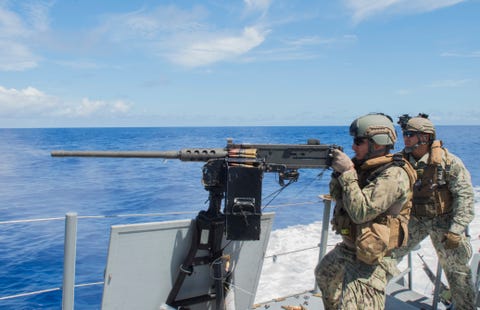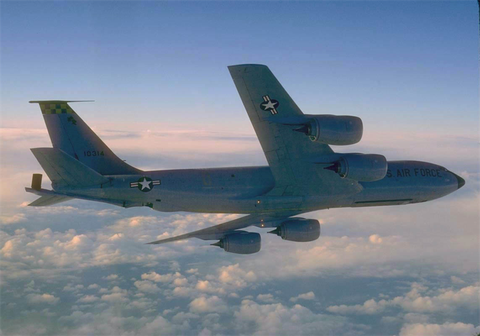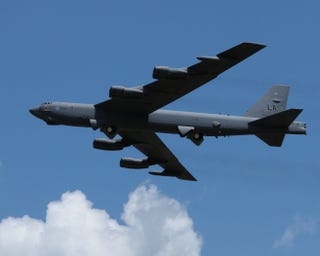3 of the Oldest Weapons in the Pentagon’s Inventory
If it ain't broke, why fix it?
By Kyle Mizokami
U.S. ARMY RESERVE PHOTO BY SPC. JOHN RUSSELL
For a country with a $600 billion dollar defense budget, the United States still uses a sizable amount of old gear. Some of the antiquated stuff is around because it works really, really well, and there’s not come along anything better to replace it with. In other cases attempts to replace the equipment have floundered, usually for reasons having to do with complexity or cost.
Over at Task & Purpose, veteran defense reporter Tom Ricks has posed a question: What is the U.S. military’s oldest piece of gear? Here at Popular Mechanics we dug up three examples that rank among the oldest still in action: the M2 heavy machine gun, KC-135 Stratotanker, and B-52H bomber.
Even though one of these weapons dates back to World War I, the Pentagon does not have plans to retire any of them any time soon.
The M2 Heavy Machine Gun

M-2 Heavy Machine Gun aboard a Mark VI patrol boat in the Philippine Sea.
U.S. NAVY PHOTO BY PUBLIC AFFAIRS OFFICER, LT. MARY E. SMITH
The M2 heavy machine gun is the undisputed survivor of the Pentagon Wars, and this year 2018 marks the M2’s 100th birthday. The M2 was developed by legendary gun designer John Moses Browning, who also developed the Colt .45 M1911A1 handgun, the Browning Automatic Rifle (BAR) squad automatic rifle. Browning was responding to a request by General John “Blackjack” Pershing for a heavy machine gun for use in the trenches of World War I.
Today the M2 still serves with each of the armed services and the Coast Guard. In the Army it is generally used by vehicle crews, including M1A2 Abrams tanks, while the Marines use a tripod-mounted version and on vehicles. The Navy and Air Force use it to defend ships and air bases. The M2 is an air cooled machine gun shooting the heavy .50 caliber round at a rate of fire from 450 to 550 rounds per minute, out to a range of 1,250 yards. The M2 can penetrate an inch of armor plate at 1,000 yards.
The original M2 weighs 85 pounds, but the U.S. Army is currently working on a lighter version it projects will weigh 20 to 30 percent less. Despite occasional improvements to the basic design however there is no replacement for the M2 in sight and the “Ma Deuce” could very well serve until the 22nd century.
KC-135 Stratotanker

KC-135 Stratotanker.
U.S. AIR FORCE
During the Cold War, the U.S. Air Force purchased 732 Boeing 707 commercial airliners and turned them into tankers. The KC-135 Stratotanker was equipped with aerial refueling booms and enough internal fuel storage to transfer up to 32,200 gallons of fuel to thirsty fighters, bombers, and transports per mission. The KC-135 could also transport up to 41.5 tons of cargo at a time in an internal cargo hold.
Boeing began delivering KC-135s in 1957 and the airborne tanker fleet supported Strategic Air Command bombers flying patrols against the Soviet Union, U.S. air operations over Vietnam, and even Operation Desert Storm in 1991. The Air Force, Air Force Reserve, and Air National Guard still fly 414 KC-135s today. Although each plane is an average of 58 years old the KC-135 fleet will fly on for decades to come, with no real replacement waiting in the wings.
B-52H Heavy Strategic Bomber

B-52H bomber.
U.S. AIR FORCE.
The B-52H bomber was designed to carry thermonuclear bombs to the Soviet Union and back. The B-52 was conceived immediately after the end of World War II and first flew in 1952. The first B-52H bomber was delivered in 1961 and the last in 1963.
Today 76 of the original 102 B-52Hs are still flying with the U.S. Air Force. Arms control agreements and platform obsolescence has forced the conversion of the planes into conventional-only bombers, their ability to carry nuclear weapons permanently stripped out. The B-52 currently provides a versatile, long-range platform that can drop precision bombs on enemies without advanced air defenses such as the Islamic State, launch long range standoff weapons like the Joint Air to Surface Standoff Missile - Extended Range against enemies with more sophisticated air defenses, and even lay minefields at sea with “Quickstrike” air-dropped naval mines.
The Air Force plans to re-engine the bombers, making them cheaper and more reliable, keeping them in the air well into the 2030s, at which point the B52H fleet will be an average of 70 years old. Of the three bombers currently in the Air Force’s fleet the service will retire the B-52H last, after the B-1B and B-2A.
While these are the oldest, there are other bits of (slightly younger) aging tech still at work. Take, for instance, the Air Force’s T-38 Talon jet trainer, which entered service in 1961, and the Navy’s Landing Craft, Utility (LCU), which entered service in 1959. The T-38 will be replaced by the new T-X trainer, while a LCU replacement is expected to come online in 2022.
After all, if it ain't broke, why fix it?
No comments:
Post a Comment